Connecting the dots
Physical chemist uncovers nanoparticle behavior
By Michelle Geering
 A love of science fuels Christine Aikens’ quest for better understanding of electron movement.
A love of science fuels Christine Aikens’ quest for better understanding of electron movement.
The Kansas State University distinguished professor of chemistry in the College of Arts and Sciences aims to understand the relationship between the structure and the properties of nanomaterials. She is especially interested in gold and silver nanoparticles for future practical applications.
The U.S. Department of Energy is funding Aikens’ research on electron dynamics in nanoparticles. Understanding these processes could lead to more efficient solar cells and cleaner energy in the future, she said.
“We are trying to understand the physical phenomena that occur when nanoparticles are excited by light,” Aikens said. “If we can understand the underlying physics of these systems, then we can figure out what knobs we need to turn to tune everything to make it practical.”
Aikens’ research has been instrumental in rethinking the plasmon resonance, which is the collective motion of electrons in nanoparticles and is responsible for many properties of nanoparticles.
“The plasmon resonance was always treated in a certain way and scientists did not think you could have plasmons in smaller particles,” Aikens said. “We were able to show that it is really a continuum and that you do still have plasmon-like processes in smaller nanoparticles.”
Aikens’ research group is now studying what happens after the plasmons get activated and how the activation works.
“One of the applications of interest right now is solar cell sensitizers,” she said. “The idea would be that light comes in and excites some electrons in the nanoparticle and then those electrons may be transferred to other parts of the solar cell. The nanoparticles might work as a catalyst. Or there might be another molecular transformation going on and something about the nanoparticle or its interaction with light changes the environment of the reaction that would occur. We’ve been trying to figure out the fundamentals of these reactions and how the process works.”
With National Science Foundation funding, Aikens and her team are working on two projects to explore photoluminescence of nanoparticles. Photoluminescence is how the nanoparticles give off light.
In one collaborative project, Colorado State University researchers are synthesizing nanoparticles and Pennsylvania State University researchers are measuring their optical properties. Aikens’ group performs theoretical calculations that aid in understanding the experimental results.
In a second project, graduate students in Aikens’ group are developing theoretical methods that can be applied to calculate photoluminescence in nanoparticles. They derive mathematical equations and write computer code to develop methods that are both accurate and computationally efficient.
Aikens has contributed significant findings during her career with more than 120 peer-reviewed publications. Since joining K-State in 2007, she has earned more than $3.8 million in research funding. She also has received numerous honors, including a National Science Foundation CAREER award in 2010 and the 2020 Women Chemists Committee of the American Chemical Society Rising Star Award.